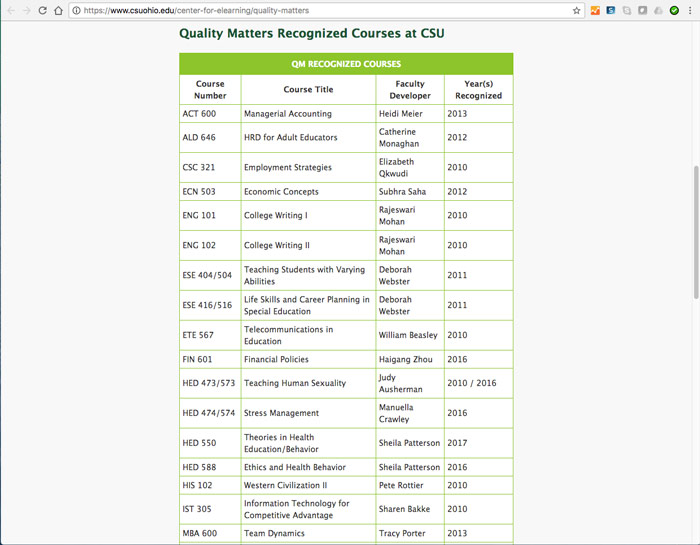The web can be a powerful tool to communicate the important work of continuous improvement through quality assurance. Start with your organizational website. By creating a page that focuses on your work with the QM quality assurance system, you can inform your community — faculty, staff, learners, parents, and other stakeholders — about how you are delivering on the promise of online learning. Here are some ideas for what to include on the web page:
What is QM?
Start with the basics. Let your community know what QM is and why it matters. It’s important for staff and others to understand your organization’s partnership with QM and how Quality Matters helps you achieve your quality assurance goals.
The following statement can be used to summarize the QM quality assurance system:
Quality Matters provides professional development, a set of rubrics, and a course peer review process that work together to support faculty in improving the quality of online and blended courses. QM has received national recognition for its faculty-centered approach to continuous improvement in online education and student learning. QM has review processes for both online and blended courses, and online programs.
QM Rubrics and Standards were created to help course developers, teachers, faculty, entire organizations, and — most importantly — students. The General Standards and Specific Review Standards in each Rubric are intended to guide you through the development, evaluation, and improvement of your online and blended courses. The Rubric and associated annotations are based on best practices that promote student learning and instructional design principles for quality course design. The Rubric is supported by a thorough review of the research literature and is updated periodically to reflect new techniques and technologies that have become available.
The course review process involves a review of a course by a team of trained, certified peer reviewers who are all experienced online faculty. This faculty-driven process is intended to be diagnostic with the overall goal of course improvement. It does not involve pass/fail judgments but instead relies on the team members providing specific guidance for the course developer on what might be done to modify the course in order for it to meet QM Standards. There is clear recognition throughout the process that there are many ways to meet each Standard and that no course is perfect. To receive QM Certification as a quality course, a course must meet Rubric Standards at 85% or higher in the overall scoring by the review team.
The Quality Matters process is designed to ensure that courses undergoing review will eventually meet Standards and receive QM Certification.
Check out this example from the University of Arkansas.
What’s Your Plan?
Once your community understand what QM is and why it matters, it’s important to communicate how you are using QM. In other words, what’s your plan? You’ll want to include specific information like Kent State University has done. For example, Kent State includes an entire section on how they use QM and details the different review options that are available as well as a template for course design.
How Can Staff Continuously Improve?
Use the web page (and possibly other areas of your website) to showcase professional development opportunities for staff. Not only does this help staff see what’s available, but it also highlights your commitment to continuous improvement to your community. Items to include are:
- Workshops available
- Workshop descriptions
- Dates
- Cost
- Who pays for the workshop
- Who needs to take the workshop
- Why staff should take the workshop
For more information and ideas, check out what the University of North Alabama has done to promote professional development opportunities on their websites.
What Have You Done Lately?
The Cleveland State University's webpage showing courses that have been QM Certified.
Finally, be sure to share your organization’s QM achievements including:
- Becoming a QM Member
- Staff completing QM Workshops or Courses
- Attendance or Presentation at QM Conferences
- Certified Courses
- Certified Programs
Highlight these accomplishments on your website so that everyone can see the steps you are taking to create a culture of continuous improvement and deliver on your online promise. For inspiration take a look the Cleveland State University's website.
These ideas are a great start, but there is so much more you can do! Explore the links above for ideas on how to showcase your commitment to quality assurance in online learning on your website. When you create your page, let us know! Share it on Twitter, Facebook or LinkedIn — use #QMNews or #weuseQM and be sure to tag us at @QMProgram. The QM community wants to see the great work you’re doing, so thank you for sharing.

